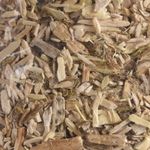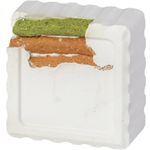Keep small animals inside or outside during winter?
Go to
- A nice and warm winter fur makes all the difference
- Pros and cons
- Preparing a small animal house for the winter: 5 tips
- Making a final decision ... inside or outside?
- Rabbits in winter
- Ferrets in winter
- Guinea pigs in winter
- Rats and mice in winter
- Gerbils in winter
- Degus in de winter
- Hamsters in winter
- In a nutshell

A nice and warm winter fur makes all the difference
Pros and cons

Disadvantages of spending the winter outdoors
- Paying enough attention to your furry friends is often a challenge on rainy days
- There’s more work to do in winter, such as replacing frozen bottles and regularly checking your small animal’s hutch.

Disadvantages of spending the winter indoors
- Lack of space is in some cases a problem when bringing in small animals
- Allergies in the family? Keeping your pet indoors isn’t always possible in certain situations
- Outdoor pets do not always like to stay inside the house

Advantages of spending the winter indoors
- It’s easy, because you no longer have to go outside in the rain or on cold days
- It’s less work, because it’s not necessary to defrost frozen bottles every time
- It’s cosy and you automatically get more contact with your small animal when it’s living inside

Advantages of spending the winter outdoors
- Your gnawer is kept in its own environment and does not have to get used to a new place inside the house
- No mess in the house, smells and dirt stay outside and your house stays clean
Preparing a small animal house for the winter: 5 tips
While some small animals can easily hibernate outdoors, there are others that need your help. Have you thought everything through carefully and decided to house your small animal outside during the winter? Then it’s a good idea to prepare the small animal hutch for the winter. Read some tips below.
Tip 1: Protection from the wet is absolutely essential
Tip 2: Protect the hutch from wind and draughts
Tip 3: Insulate the rabbit hutch in winter
Tip 4: Together is always warmer than alone
Tip 5: Winter tools for your rabbits and small animals
Making a final decision ... inside or outside?
It’s important to know that you can’t keep moving your rabbit or small animal from indoors to outdoors or vice versa. If the outside temperature differs from the room temperature by more than 10 degrees, it’s certainly not a good idea to move your pets indoors or outdoors. This is because the fur of your rabbit or small animal adapts to the ambient temperature.
It quickly becomes too warm inside for animals with a winter coat. An animal without a winter coat, on the other hand, will be too cold outside. It’s therefore good to choose indoors or outdoors and not to change your mind before the new (warmer) season arrives.

Rabbits in winter
Rabbits can cope with the cold fairly well, but tend to suffer from too much heat. Your rabbit can already get into trouble at temperatures up to +25 degrees, but colder days up to -10 degrees are easily tolerated. So it’s no problem to keep your rabbits outside in winter, provided your rabbit isn’t ill and has a thick winter coat. Your rabbit’s winter fur starts to grow around August, so it’s best to keep your rabbit outside when this starts to happen.
Are you moving your long-eared friend to the outdoors after or during the shedding season? Then the winter fur will not be developed well enough and your rabbit will get cold. Besides good health and a warm winter coat, it’s important to house your rabbits in pairs or groups. Rabbits living alone lack the warmth of a companion to keep them warm. Rabbits are true group animals and should not be kept alone. But apart from that, bringing 2 rabbits together in the winter months also has a positive effect: it provides extra warmth!
Ferrets in winter
Ferrets also have two different types of coat: a summer coat and a winter coat. Your ferret’s winter coat has a thick undercoat so it can keep itself warm during the winter. Leaving ferrets outside in the winter is a wonderful idea, but their hutch will need some adjustments on cold days.
This means the hutch must be insulated, draught-free and provide sufficient warmth. To provide your ferret with extra warmth it’s better not to use straw. This can cause problems with your ferret's respiratory system. You can provide extra warmth for winter days by offering your ferret warm fleece blankets or a warm fleece ferret house. The main thing is to provide a warm place for your ferret to retreat to for a nap on cold days.



Guinea pigs in winter
It’s possible to keep your guinea pig outside in winter, or rather your guinea pigs. A guinea pig is a group animal and should be kept in pairs or groups, especially during the winter months. This way, your guinea pigs can keep each other warm by snuggling up together. It's also important that your guinea pigs are in good health. Sick or pregnant animals need to be protected from the cold and shouldn't be left outside on cold days.
In addition to good health and a good group structure, it’s necessary to provide a protected outdoor area. The outdoor hutch for guinea pigs in winter should be draught-free and provide warmth and protection on colder days. It's also a good idea to provide them with the necessary hiding places. Don't you have this option? Then it's a good idea to keep your guinea pigs inside for the winter, where they'll be warm and cosy. Of course, there are several ways to prepare your current guinea pig house for the winter. See how to do this below.
Rats and mice in winter
Rats and mice can cope fairly well with lower temperatures, but feel most comfortable at temperatures between 15 and 21 degrees. Most rats and mice prefer to stay indoors where it’s warm and comfortable. Would you like to keep your pet rats or mice outside? Make sure your hutch is insulated and provides enough warmth for your pet to feel comfortable. Rats and mice are particularly sensitive to draughts in the hutch. Draughts make the animals sick and can have a serious effect on your pet’s health.
It’s therefore important that the outdoor hutch of your pet rat or mice is draught-free, provides warmth and is well protected against winter weather conditions. Use enough nesting material to keep your pets warm and to ensure that the heat is retained longer in the hutch.


Gerbils in winter
Gerbils are very sensitive to draughts and have a poor tolerance for the cold. The ideal room temperature for these small animals is between 20 and 24 degrees. Frost and days with sub-zero temperatures are therefore far too cold for your gerbil. A nice fact about gerbils in winter is that in the wild this little gnawer lives mostly underground.
An enormous network of tunnels about one and a half metres underground offers the perfect temperature for these small animals. As our pets often don't have this opportunity, we recommend that you let your gerbil hibernate indoors in a nice, comfortable and warm enclosure.

Degus in winter
Many people don’t know it, but degus also have a winter coat. Your degu can therefore stay outside during the winter months, provided you take the right measures.
It’s also important to know that degus are best kept in groups, a degu kept alone will quickly feel lonely and miss the warmth that animals can offer each other. Provide a draught-free and moisture-free night shelter and offer opportunities for the degus to dig themselves into nesting material for extra warmth.

Hamsters in winter
Unlike rabbits, hamsters don’t have a nice warm winter coat. It’s therefore much harder for your hamster to survive in a cold environment. The ideal temperature for your hamster is between 18 and 23 degrees. If the temperature drops to 15 degrees or below, your hamster will become less active. Syrian hamsters may even hibernate if the temperature drops too low. It’s therefore not recommended that you leave your hamsters outside in the winter without heating. It’s much better to keep your little one warm and cosy inside a small animal cage.
























